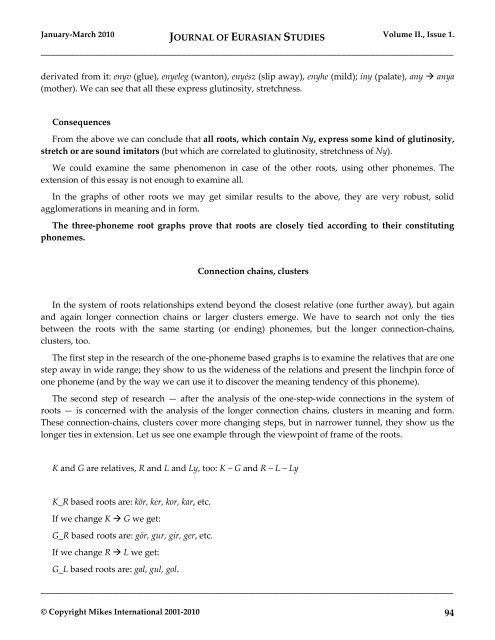EurasianStudies_0110..
EurasianStudies_0110..
EurasianStudies_0110..
Create successful ePaper yourself
Turn your PDF publications into a flip-book with our unique Google optimized e-Paper software.
January-March 2010 JOURNAL OF EURASIAN STUDIES Volume II., Issue 1.<br />
_____________________________________________________________________________________<br />
derivated from it: enyv (glue), enyeleg (wanton), enyész (slip away), enyhe (mild); íny (palate), any anya<br />
(mother). We can see that all these express glutinosity, stretchness.<br />
Consequences<br />
From the above we can conclude that all roots, which contain Ny, express some kind of glutinosity,<br />
stretch or are sound imitators (but which are correlated to glutinosity, stretchness of Ny).<br />
We could examine the same phenomenon in case of the other roots, using other phonemes. The<br />
extension of this essay is not enough to examine all.<br />
In the graphs of other roots we may get similar results to the above, they are very robust, solid<br />
agglomerations in meaning and in form.<br />
The three-phoneme root graphs prove that roots are closely tied according to their constituting<br />
phonemes.<br />
Connection chains, clusters<br />
In the system of roots relationships extend beyond the closest relative (one further away), but again<br />
and again longer connection chains or larger clusters emerge. We have to search not only the ties<br />
between the roots with the same starting (or ending) phonemes, but the longer connection-chains,<br />
clusters, too.<br />
The first step in the research of the one-phoneme based graphs is to examine the relatives that are one<br />
step away in wide range; they show to us the wideness of the relations and present the linchpin force of<br />
one phoneme (and by the way we can use it to discover the meaning tendency of this phoneme).<br />
The second step of research — after the analysis of the one-step-wide connections in the system of<br />
roots — is concerned with the analysis of the longer connection chains, clusters in meaning and form.<br />
These connection-chains, clusters cover more changing steps, but in narrower tunnel, they show us the<br />
longer ties in extension. Let us see one example through the viewpoint of frame of the roots.<br />
K and G are relatives, R and L and Ly, too: K – G and R – L – Ly<br />
K_R based roots are: kör, ker, kor, kar, etc.<br />
If we change K G we get:<br />
G_R based roots are: gör, gur, gir, ger, etc.<br />
If we change R L we get:<br />
G_L based roots are: gal, gul, gol.<br />
_____________________________________________________________________________________<br />
© Copyright Mikes International 2001-2010 94

















